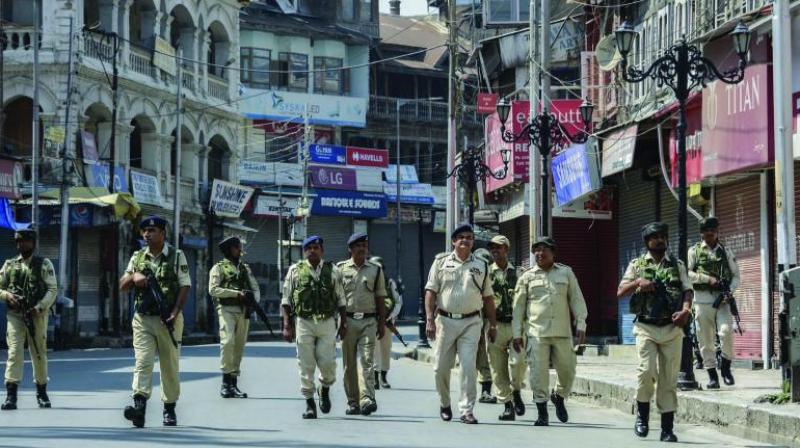Kashmir will not react and erupt in anger, Kashmir will respond
For now, the middle ground in Kashmir stands obliterated. In a new battle for existence, the multiple identities of Kashmiris have become paramount.

The dawn of August 5, 2019 came on Kashmiris like a betrayer. Exactly 66 years ago, on August 9, 1953, Sheikh Mohammad Abdullah was arrested from the picturesque tourist resort in north Kashmir, Gulmarg. The Sheikh was also unceremoniously removed as Prime Minister of Jammu and Kashmir. When it comes to Kashmir, there is hardly anything “august” about August.
The unilateral decision taken by the BJP-led government in New Delhi on August 5 to abrogate Articles 370 and 35A of the Indian Constitution stunned the Unionist camp in J&K the most. One of the said Articles defined the relationship between Srinagar and New Delhi while the other granted powers to the J&K Legislative Assembly to define who the permanent residents of the state were and then accorded to them several rights and privileges, including the right to jobs, scholarships, education and also the right to buy immovable property.
As part of their politics for relevance on Kashmir’s political landscape, the Unionists until recently favoured a solution to the political dispute within the framework of the Indian Constitution. Their demand was that New Delhi should turn the clock backwards to 1953 when J&K enjoyed considerable autonomy besides having its own constitutionally approved posts of Prime Minister and Sadr-e-Riyasat instead of chief minister and governor respectively.
J&K’s National Conference (NC), the region’s oldest political formation after the All Jammu and Kashmir Muslim Conference in 1931, would prefer autonomy while the People’s Democratic Party (PDP) advocated self-rule for the two divided parts of J&K.
In an expected move, the BJP government stripped J&K of its autonomy and statehood besides reorganising the region by carving out two separate Union territories, viz. Ladakh and Jammu and Kashmir. This new unpalatable reality has left J&K’s Unionists gasping for breath. As if they are put on a ventilator to survive on the complex political chessboard of Kashmir. What will they do now? How will they go before the people again and with what agenda? Being at the precipice of irrelevance because of their failure to prevent humanitarian crises in 2008 and latest in 2016, the mainstream politics of Kashmir has now possibly also lost a battle for a narrative.
Expectedly, the ruling dispensation is using the powerful corporate-owned TV channels based in Noida and Mumbai to manufacture consent for its contentious decision over Kashmir’s political fate. Significant sections of the Indian media continue to act as willing partners in crime to distort or kill the Kashmir story. The use of propaganda and persuasion dates back from the beginning of Greek analysis of rhetoric and has been used in various settings since. Adolf Hitler had created a separate ministry for propaganda, headed by Joseph Goebbels, in Germany.
Despicable acts like mass detentions, an information blackout, snapping of communication lines including mobile telephones and the Internet, the caging of over eight million Kashmiris, and shutting down of schools, colleges, markets and major mosques are being marketed as the new indicators of normalcy for Kashmir.
Without a doubt, the local Kashmiri population sees the BJP’s decision as an assault on ethnic identity and an existential threat to the Kashmiri race. With the objective to control the narrative on the mainstream as well as social media platforms, most TV channels and their fidayeen anchors are busy weaving a fallacious and malicious “everything is normal in Kashmir” narrative. And then ugly practices to humiliate, caricature and demonise Kashmiris as the new “other” has been normalised by now.
Kashmir is so normal that over 4,000 persons, according to a report by AFP, have been detained since August 5. Three former chief ministers, Farooq Abudullah, Omar Abdullah and Mehbooba Mufti, are among those held. Yes, Kashmir is so normal that top Congress leaders Rahul Gandhi and Ghulam Nabi Azad were sent back to New Delhi from the Srinagar airport.
For now, the middle ground in Kashmir stands obliterated. In a new battle for existence, the multiple identities of Kashmiris have become paramount. In a caged Kashmir, the people are in a quest for freedom of speech and freedom after speech. As a collective, Kashmiris feel disrobed, dispossessed, disempowered.
On its part, New Delhi neither bothered to seek the consent of the natives nor of the Kashmiri leadership in and outside the electoral fold. Kashmiris feel they have been taught what to do, not what to know. Kashmiris believe they are expected to either surrender or perish. In short, Kashmiris have been silenced. Besides trying to instil a sense of defeat in the hearts and minds of the Kashmiri populace, the aim behind the current lockdown also appears to telegraph the following messages:
New Delhi won’t bend,
Kashmiris need to accept new ground realities as their fate,
The Kashmir dispute does not exist,
What next from here?
On the internal front, a spike in armed militancy appears a given. The intensity of the conflict in Kashmir could go up by several notches. On the external front, the ongoing hostility between Pakistan and India is expected to touch newer heights. The battleground could also shift from Kashmir to various parts of mainland India. Coverage of Kashmir by the international media would possibly dent India’s image abroad.
The most critical factor, however, is the response from the ordinary Kashmiris. They seem to have realised the fact that an angry athlete makes mistakes. They are aware that the same tactic or the same strategy won’t fetch different results. Those having their ears on the ground pick the word on the street and say that ordinary folks are preparing a mature response, which could take everyone by surprise.
Let’s not forget that Kashmir is a graveyard of reputations!

